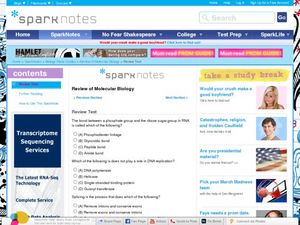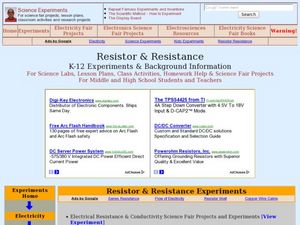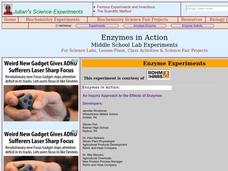Curated OER
Extending the Acid/Base Concept
In this acid and base learning exercise, students answer 4 questions about the definitions of acids and bases. They illustrate the differences between Arrhenius and Bronsted acids and bases and draw Lewis diagrams for the formation of...
Physics LAB
Distinguishing 2nd and 3rd Law Forces
In this laws of forces instructional activity, students are given 27 problems to solve given diagrams showing forces acting upon objects. Students find the forces acting upon the objects, the determine the opposing forces acting upon the...
Curated OER
Insulated gate bipolar transistors
In this transistor worksheet students investigate what an insulated gate bipolar transistor is and answer 5 detailed questions about their application and structure
Curated OER
Reducing Air Pollution
In this critical thinking instructional activity, students evaluate different scenarios to decide how the person or business in the scenario could help reduce air pollution. Students work in cooperative learning groups to decide what...
Curated OER
Lesson 5: Technology: Conveniences and Consequences
Students identify positive and negative impacts of technology. In this technological advancements lesson, students consider how toxic pollution affects the Earth and its inhabitants. Students participate in 3 activities that allow them...
Curated OER
Rockets!!
Students launch a rocket. In this laws of motion lesson, students discuss the forces of flight, how a plane flies and how a rocket gets off the ground. Students watch a video about rocket launches, discuss Newton's Third Law of Motion...
Curated OER
Albert Einstein
In this online interactive history quiz worksheet, students respond to 50 multiple choice questions about Albert Einstein. Students may submit their answers to be scored.
Curated OER
Werner Heisenberg
In this online interactive history quiz worksheet, students respond to 50 multiple choice questions about the accomplishments of Werner Heisenberg. Students may submit their answers to be scored.
Curated OER
Max Planck
In this online interactive history quiz worksheet, students respond to 49 multiple choice questions about the accomplishments of Max Planck. Students may submit their answers to be scored.
Curated OER
Review of Cell Structure
In this cell structure activity, students complete 50 multiple choice question review quiz about the different functions and parts of the cell.
Curated OER
Review of Cell Reproduction
In this biology review worksheet, students complete 50 multiple choice questions on the stages of mitosis and meiosis. They compare and contrast the two.
Curated OER
Review of Molecular Biology
In this molecular biology worksheet, students complete 50 multiple choice questions on DNA and RNA replication, translation and transcription.
Curated OER
Review of Evolution
In this review of evolution worksheet, students complete 50 multiple answer questions on Darwin's theory and the history of life on Earth.
Curated OER
Review of Animal Behavior
For this animal behavior worksheet, students complete a 50 multiple choice question review quiz on how animals respond to certain stimuli.
Curated OER
Review of Chemical Solutions
In this chemistry review activity, students answer 50 multiple choice questions on solutions. They identify different types of solutions and ways to express concentration.
Curated OER
Effects of Bread Sanitary Conditions on Mold Growth
Students examine fungi and where it comes from. In this mold lesson students determine the percentage of fruit juice in a fruit then identify the different types of mold.
Curated OER
Battery Charger
High schoolers explain how battery chargers work. In this physics lesson, students discuss the two main ways that vehicles get charged. They build their own battery charger.
Curated OER
Resistor and Resistance
Students explore electrical resistance through various experiments. For this physics lesson, students calculate resistance using a mathematical formula. They explain how colors identify the resistance value of a resistor.
Curated OER
Enzymes in Action
Students explore how enzymes are important in the chemical reactions of all living things. In this enzymes and catalysts lesson students complete an activity to see how enzymes change living things.
Curated OER
SORTING ALL SORTS
Learners examine how the method of classification is used. In this sorting lesson students take a pre-test, classify organisms and complete a crossword puzzle.
Curated OER
Fingerprinting
Young scholars list and describe the three types of fingerprint patterns. They list and describe three layers of fingerprints that can be made. They explain why we leave fingerprints.
Curated OER
Building a Roller Coaster
High schoolers describe the law of conservation of energy. They identify the conversion between potential and kinetic energy. They investigate and describe the application of Newton's Laws of Motion.
Curated OER
Pollution Prevention in Schools
Learners review P2 concepts they learned in previous lessons and explore how to reduce the pollution in their school. They also examine ways to conserve energy.
Curated OER
Evolution Lab
Students examine the pattern of natural variation in a society. They examine Darwin's theory of evolution and analyze data. They use computer programs to graphically display the variation in organisms.
Other popular searches
- Grade 9 Applied Science
- Pure and Applied Science
- Edexcel Btec Applied Science
- Applied Science Physics
- Pure vs Applied Science
- Ks4 Applied Science
- Basic vs. Applied Science
- Bet Applied Science
- Basic vs Applied Science
- Btec Applied Science
- Applied Science Bartendng
- Ed Excel Bet Applied Science

























